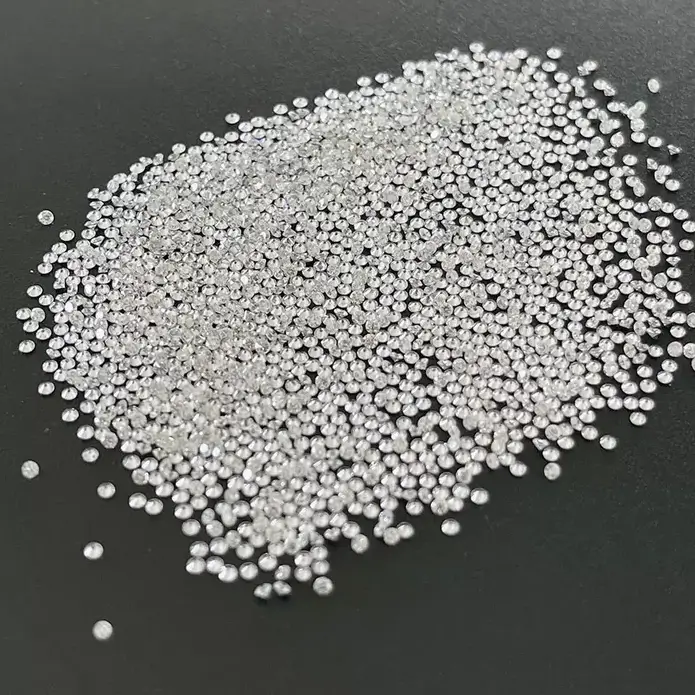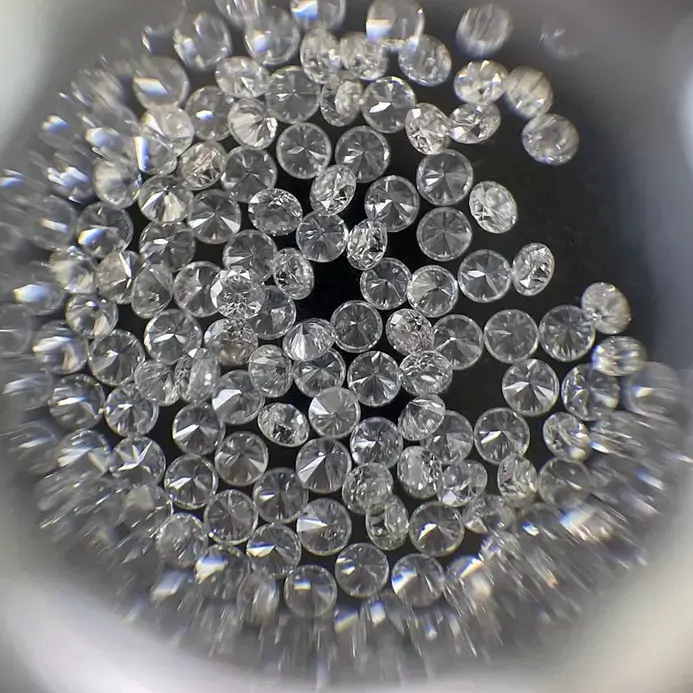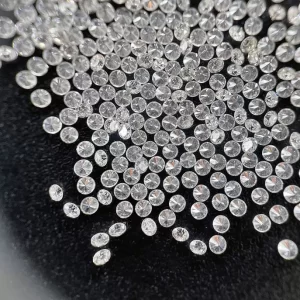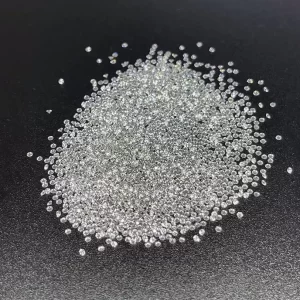DEF VS SI 1.2mm 1.3mm 1.4mm Man Made Melee Diamonds For Rings
DEF VS-SI 1.2mm 1.3mm 1.4mm Man Made Melee Diamonds For Diamond Rings
Man Made Melee Diamonds Description
Diamonds are famous all over the world as luxury and precious jewelry. However, it is also the hardest substance in nature, a good heat conductor and an inert substance. These characteristics mean that diamonds can play an important role in some industrial applications, such as metal cutting, drilling, grinding, mining and construction, as well as applications in high-pressure testing and high-performance bearings.
Lab grown diamonds is usually produced by chemical vapor deposition (CVD) or high pressure high temperature (HPHT).
For a long time, people believed that diamonds could only be created under high pressure and high temperature conditions, imitating the formation of natural diamonds. This is called HPHT(high pressure and high temperature) method.
However, in the late 1980s, scientists discovered how to use a method called chemical vapor deposition (CVD) to create diamonds. Diamonds produced by CVD are produced by mixing hydrocarbons, usually methane, with hydrogen in a low-pressure vacuum chamber. The diamond will grow in a few days until it reaches the size required for the specific application. Normally, when methane and hydrogen are mixed, carbon is produced in a non-diamond form, such as graphite. In the CVD chamber, microwave energy, electric discharge, or hot cathode is used to generate hydrogen atoms, which react with non-diamond carbon to form vapor. Highly active hydrocarbon vapors will further react with hydrogen atoms, resulting in the separation of hydrogen and pure carbon, and pure carbon is deposited as diamonds. With the repetition of this process, the diamond can grow into different sizes according to the required application.
The Difference Between Natural and Man Made Melee Diamonds
When it comes to diamonds, there are two types – natural and lab grown. The former is a type of lab grown diamond and is far more expensive than the latter. The latter is a synthetic stone, produced by a chemical vapor deposition process. Both are valuable stones, but despite their low carat weight, they are not a good choice for everyone. Read on to learn the differences between natural and lab grown diamonds and their costs.
Lab grown diamonds
For many years, lab grown diamonds have been a largely unnoticed alternative to natural melee. However, the introduction of these diamonds has caused some controversy, as some early manufacturers marked their stones with a logo, while modern manufacturers have put numbers on the girdle. Despite this controversy, lab grown diamonds have become the biggest market for diamonds. Whether or not you should invest in a lab grown stone depends on your budget and desired look.
The most common form of melee diamonds is a round, miniature diamond. This type of diamond is relatively small and typically ranges from 0.001 to 0.2 carats. Their unique design makes them ideal for accent stones in rings. They are typically not faceted and have jagged edges, but are polished and cut just like larger diamonds. They display textbook sparkle. Regardless of their size, they are considered valuable gemstones.
Although it is hard to determine the exact percentage of lab grown diamonds, one thing is certain: the cost of the stone will be a factor. If you are unsure of whether or not your diamond is lab grown, you can pay more and avoid the hassle of trying to identify the diamond. Most labs now offer this service. If you have a particular stone in mind, consider having it examined by a third party.
When it comes to determining the exact carat weight of your diamond, make sure you know the difference between melee and natural. The difference between lab grown and natural diamonds is often not readily apparent unless you know what you’re looking for. The best way to tell whether a diamond is lab grown is to check the quality of the gem. There are several things to look for, and a certified lab can tell you everything you need to know.
One way to tell the difference between a natural diamond and a lab grown diamond is to check its color. Melee diamonds can be distinguished by their color, but their size makes it impossible to test them without dismounting them from their mountings. Fortunately, China has made this method more efficient and cost-effective. You can even purchase man-made melee diamonds that have no visible flaws.
Chemical vapor deposition method
Chemical Vapor Deposition, or CVD, is a process that creates a synthetic diamond. This method uses highly active hydrocarbon vapors to form diamonds. The hydrogen atoms are separated from the carbon atoms and form pure carbon that grows to different sizes. The process of CVD is more complex than HPHT, and the final product can be a diamond of any shape.
Because it is so small, melee diamonds are typically cut into tiny round diamonds. Earlier, these diamonds had only 17 to 18 facets, making them difficult to handle and test. Fortunately, modern technology allows for 57 and 58-faceted round brilliants. Still, it is important to know the difference between natural and lab-grown diamonds. While the facets and colors of a natural diamond can be compared, these small diamonds are more likely to be natural, and it is possible to mistake a man-made one for a natural one.
Due to recent advances in technology, synthetic diamonds are increasingly being used in industrial applications. As a result of this, they are increasingly becoming the center stone and fine jewelry alternative. They are often used as melee, which are small diamonds ranging from 0.001 to 0.018ct. in weight. In fine jewelry, melee diamonds are used as micro pave diamond bands.
The HPHT and CVD methods are often used for the creation of manmade diamonds. Both methods begin with a diamond seed crystal. Microwaves then break down the gas and deposit the carbon atoms onto the diamond seed. The process can take anywhere from two weeks to two months, and the finished diamond is created. Because the CVD method uses high pressure and temperatures to grow diamonds, each diamond is unique and has a slightly different crystal structure and strain pattern. The main differences between natural and synthetic diamonds are price and quality.
Scientists developed a new way to make diamonds in the lab. This method is called chemical vapor deposition. This method involves mixing hydrocarbons with hydrogen and then heating them to a relatively high temperature, usually between 800 and 1,000 degrees C. A small seed crystal is placed at the bottom of a growing chamber filled with carbon-rich gas. A microwave beam heats the gas vapor at a high rate. This causes carbon atoms to precipitate from the gas cloud and deposit on the seed crystal.
Cost
There is a great deal of confusion surrounding the production of man-made melee diamonds. The production of melee diamonds is similar to the production of other types of lab-grown diamonds. This process is known as chemical vapor deposition or CVD. It involves the use of a vacuum chamber for gasses in the atmosphere to deposit material by heat or plasma. The cost of these diamonds depends on the quality of the materials used.
Melee diamonds are typically cut into small round diamonds. Earlier, they were only given 17 to 18 facets. But nowadays, thanks to machine cutting, these diamonds are shaped to resemble round brilliant diamonds, which have 57 to 58 facets. Before buying a diamond, make sure to know whether the stone is natural or lab-grown. The difference in price is minimal and will be obvious after you see the stone.
A good way to know the value of a melee diamond is to purchase it from a wholesaler. Wholesalers sell melee diamonds to jewelry designers in parcels. They set a price for the parcels, which allows the jewelers to sell them to consumers. The price for each parcel is based on the carat weight of all the diamonds in the parcel. The value of a melee diamond depends on the overall impact of its jewelry.
Because melee diamonds are relatively small, they can be inexpensive and make beautiful accents for rings. However, they should never be used as the center stone because their shape is likely to detract from the center stone. Also, a poorly-cut diamond can look jagged and distract the attention from the center stone. Instead, a well-cut melee diamond will draw the eye to the center stone.
A significant problem with melee diamonds is that their quality is not guaranteed. The manufacturing process of HPHT produces diamonds hundreds of thousands of carats per month. However, a single diamond is an insignificant problem for the natural diamond market, as it is easy to identify a synthetic with testing equipment. A more serious problem has been the contamination of melee diamonds by synthetics in 2015, which is an international issue.
Identification
There are several ways to identify synthetic diamonds, but the most accurate and reliable way is to undergo a laboratory identification process. Various reputable labs have developed highly sophisticated instruments and experienced professionals that can accurately identify man-made diamonds. Aside from expertise, these laboratories are also mindful of the cost-benefit ratio of this service, which is often not commercially justified. But if you’re in the market for a diamond, you might be wondering how to tell the difference between a synthetic and a natural one.
To make the best choice for your own jewelry, a high-precision ultrafast laser is used to place identifiers on a diamond. These identifiers are only visible at selected depths and can be applied to a variety of diamonds. The system works with diamonds up to 1mm in diameter and can be adapted for large stones. Regardless of the method, it’s a powerful way to increase the security of a stone. You can prevent fraudulent sales and counterfeits through this process.
If you’re concerned about the cost of a lab-grown diamond, consider how much time it takes to make the process. Most melee diamonds are mounted in clusters and cannot be removed. This makes it impossible to properly identify them with a handheld diamond test kit. This is because they’re too small to test without removing the mountings. Because they’re so small, they’re almost weightless, and they can attract a magnet. A diamond, however, doesn’t carry enough inclusions to attract a magnet.
While the Gemological Institute of America (GIA) defines melee diamonds as diamonds with less than 0.2 carats, they are not faceted. Instead, they are cut in a manner that resembles large diamonds, allowing for 57 to 58 facets. Single-cut melees have only 17 facets and don’t give the sparkle of a Full Cut Brilliant diamond.
There are two types of testers for melee-sized diamonds. One tests one stone at a time, while the other can test several stones at once. Handheld testers are more accurate and reliable, but they can only test one kind of stone at a time, which makes them ineffective for testing star-shaped diamonds. The latter is commonly used for identification of man-made melee diamonds in the trade.
DEF VS SI 1.2mm 1.3mm 1.4mm Man Made Melee Diamonds For Rings
















